8 Biology: The control of gene expression
1/119
There's no tags or description
Looks like no tags are added yet.
Name | Mastery | Learn | Test | Matching | Spaced |
|---|
No study sessions yet.
120 Terms
What are mutations?
Changes in the sequence of nucleotide in DNA molecules
What are 4 types of mutation?
Insertion/ deletion
Duplication
Inversion
Translocation
What are insertion/deletion mutations?
Where one or more nucleotide pairs are inserted or deleted from the sequence.
This type of mutation alters the sequence of nucleotides after the insertion/deletion point known as frameshift
What are duplication mutations?
One or more bases are repeated and therefore produces a frameshift.
What are inversion mutations?
A group of bases become separated from the DNA sequence and then re-join at the same position but in the reverse order. This therefore affects the amino acid that is produced.
What are translocation mutations?
A group of bases become separated from the DNA sequence on one chromosome and are inserted into the DNA sequence on another chromosome. This can often lead to significant effects on the phenotype.
How do gene mutations occur?
Gene mutations can arise spontaneously during DNA replication, and can be caused by mutagenic agents that affect DNA
What are the 3 causes of gene mutation?
Chemical mutagens - these include alcohol, benzene and substances in asbestos and is tar in tobacco
Ionising radiation - alpha and beta, but also UV and X-ray.
Spontaneous errors in DNA replication
What are the effects of gene mutation?
Silent - no change to organism (e.g. mutation occurs in non-coding region of DNA), or change to coding region but due to genetic code being degenerate, there is no change to tertiary structure.
Nonsense - the formation of one of the three stop codons , resulting in the production of the polypeptide being stopped prematurely.
Missense - Formation of a codon for a different amino acid.
What are stem cells?
Undifferentiated cells which can keep dividing to give rise to other cell types.
What are the 4 types of stem cells?
Totipotent
Pluripotent
Multipotent
Unipotent
What are totipotent cells?
Can form any type of cells in the body plus extra embryonic cells.
What are pluripotent cells?
These cells can form any cell type in the body, however cannot form extra embryonic cells. They are also found in the early stages of an embryo. These are often used in replacing damaged tissues in human disorders.
What are multipotent cells?
Can differentiate into other cells types but are more limited e.g. the cells in the bone marrow and umbilical cord.
What are unipotent cells?
These cells can only differentiate into one type of cell.
What are induced pluripotent stem cells (iPS)?
Pluripotent stem cells that have been created from unipotent stem cells.
What is oestrogen?
A hormone with the ability to alter transcription through altering molecules called transcription factors.
How does oestrogen effect transcription?
It can alter transcription factors which are molecules that bind to a specific site on DNA to begin the process of transcription.
There are 3 stages to the action of oestrogen in controlling transcription, what are they?
The lipid soluble nature of oestrogen means that is can freely diffuse across the cell membrane where is binds to a receptor molecule on a transcription factor.
The binding alters the shape of the DNA binding site on the transcription factor and makes it able to bind to the DNA.
The transcription factor therefore enters the nucleus via the nuclear pore where it binds to DNA. This stimulates the transcription of the gene that makes up the DNA.
What is small interfering RNA (siRNA)?
A silencing RNA molecule
What is siRNA used for?
Short term switching off of genes.
How does siRNA work?
The siRNA binds to a complementary sequence of mRNA. As mRNA is usually single stranded and the cell therefore detects the double stranded form on mRNA and views it as abnormal. Therefore the mRNA is broken down by enzymes preventing translation.
What is epigenetics?
Epigenetics involves heritable changes in gene function, without changes to the base sequence of DNA. It shows that environmental factors can make changes to the function of genes which can be inherited.
What is DNA methylation?
A process by which methyl groups are added to DNA.
How does methylation modify the function of DNA?
The methylation is through the addition of a CH₃ chemical group to cytosine bases, which both prevents binding of transcriptional factors to DNA and stimulates decreased acetylation of histones.
What is DNA acetylation?
Where acetyl group is transferred to a molecule.
What are histones?
Histones are positively charged proteins closely associated with DNA, which is negatively charged.
How does DNA acetylation result in a change in the DNA structure?
Decreased acetylation of histones increases their positive change, so they bind DNA more tightly. When this happens, transcriptional factors can no longer access the DNA, so the gene is switched off.
What causes cancer?
Cancer can arise as a result of mutation. Uncontrolled cell division in cancer leads to the formation of a tumour.
What are the 2 types of tumour?
Benign and malignant
What is a benign tumour?
Benign tumours do not tend to cause much harm apart from light mechanical damage caused by pressing against blood vessels or other cells. Benign tumours grow slowly and do not spread.
What is a malignant tumour?
Malignant tumours grow rapidly and can spread to the neighbouring cells via metastasis thus causing damage by disrupting the running of important processes. Malignant tumours are difficult to treat in comparison to benign tumours.
What is metastasis?
The spreading of cells through the blood stream or via the lymphatic system
What are proto-oncogenes?
A group of typical genes in a cell, they contain the necessary information for your body to make the proteins responsible for stimulating cell division.
What is the function of proto-oncogenes?
Stimulate cells to divide by producing proteins that stimulate cell division, allow the checkpoints of the cell cycle to be passed, and can cause cancer if mutated.
What are oncogenes?
Genes formed from mutated proto-oncogenes.
What is the function of oncogenes?
Formed from mutated proto-oncogenes and result are permanently switched on resulting in cell division that is uncontrolled. It does this by permanently activating a cell surface receptor or coding for a growth factor.
What is the function of tumour suppressor genes?
Control cell division, cause the cell cycle to stop when damage is detected. They also play a role in the programming of apoptosis (cell death). When these are switched off the cell cycle becomes unregulated.
How does abnormal methylation of tumour suppressor genes and oncogenes play a role in cancer?
Increased methylation also called hyper-methylation plays an important role in controlling tumour suppressor genes and oncogenes. The hyper-methylation of a tumour suppressor gene called BRAC1 can lead to breast cancer
How are increased oestrogen concentration linked to breast cancer development?
These elevated levels are found in fatty tissues called adipose tissue in the breast of post-menopausal women. Oestrogen binds to the transcription factor which activates the genes promoting cell division, leading to tumour formation.
Why do scientists try to determine the genome of simpler organisms?
Determining the genome of simpler organisms allows the sequences of the proteins that derive from the genetic code of the organism to be determined.
What does the presence of non-coding DNA and regulatory genes in humans mean in relation to sequencing projects?
In more complex organisms, the presence of non-coding DNA and of regulatory genes means that knowledge of the genome cannot easily be translated into the proteome.
What is a proteome?
The proteome is all the proteins that the genome can code for.
What are the advantages of gene sequencing?
Allows for genome-wide comparisons between individuals and between species.
Apart from allowing genome-wide comparisons to be made, gene sequencing has allowed for the sequences of amino acids in polypeptides to be predicted and has allowed for the development of synthetic biology.
What does comparing the genomes of individuals and between species enable scientists to determine?
Comparing genomes between species is significant as it allows evolutionary relationships between species to be determined, and it is also beneficial to medical research. Comparing genomes of individuals enables differences to be identified which can then be used for development of personalised medicine tailored to a particular genome, as well as in studies of human diseases
What is the Human Genome Project?
An international scientific project which has successfully determined the sequence of bases of a human genome.
What are potential applications of the Human Genome Project?
screening for mutated sequences
screening for carriers
pre-implantation screening
screening for disorders such as Huntington’s disease before the symptoms appear
What are the potential ethical concerns regarding the Human Genome Project?
There are many ethical concerns regarding the Human Genome Project, such as people being discriminated against as well as regarding the misuse and ownership of the genetic information.
What is recombinant DNA technology?
Recombinant DNA technology involves many ways of manipulating DNA,
What is reverse transcriptase?
The enzyme reverse transcriptase is a enzyme that is found in only some viruses and bacteria and catalyses the formation of a double strand of DNA from a single strand on RNA. This allows us to make working versions of DNA that act as genes, by extracting mRNA from cells where that gene is being expressed.
What are restriction endonucleases?
Restriction endonucleases are enzymes, extracted from bacteria, that cut DNA at specific sequences, usually six base pairs in length.
What is the difference between ‘sticky ends’ and ‘blunt ends’?
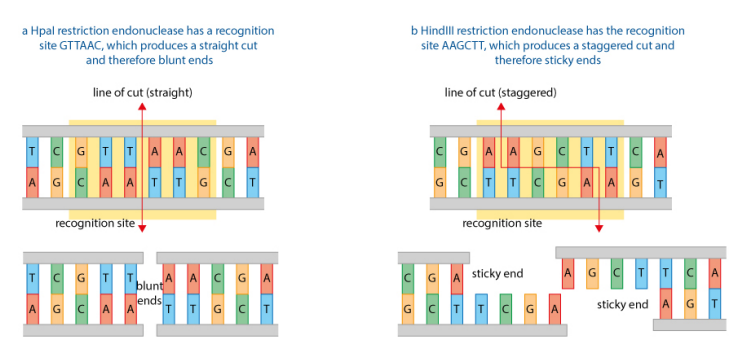
Why are ‘sticky ends’ important?
Sticky ends are important because if the same restriction endonuclease is used to cut two DNA fragments then the ends will be complementary. This allows then to attach together before stronger covalent bonds form.
Why is a vector used to insert DNA into cells?
If a DNA fragment was placed in a cell it would be digested by enzymes.
How are isolated DNA fragments placed in plasmids?
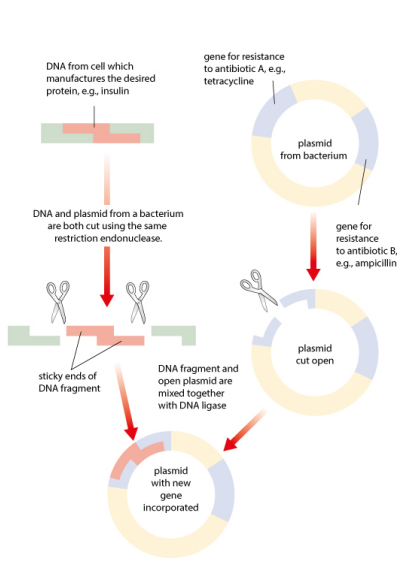
What is electroporation?
The action or process of introducing DNA or chromosomes into bacteria or other cells using a pulse of electricity to open the pores in the cell membranes briefly.
How is electroporation used in the formation of transgenic microorganisms?
In the formation of transgenic microorganisms, electroporation is used to stimulate bacterial cells to take up plasmids. Electroporation facilitates the process by increasing the permeability of bacterial membranes thus increasing the chance of success. This is achieved via the use of calcium salts and rapid temperature change from 0 to 40 degrees
What are the 3 different types of gene markers?
Antibiotic resistant genes
Fluorescent markers
Enzyme markers
How do gene markers work?
Incorporated into the plasmid so that those who have the plasmid can be separated from the bacteria that do not.
They are also used to determine whether the desired DNA has enter the plasmid, as the marker gene will become inactivated.
What is DNA profiling? Give one example.
DNA profiling is a forensic technique used to identify individuals by characteristics of their DNA. It can also be used to determine genetic relationships between organisms. One example is PCR.
What is the Polymerase chain reaction (PCR)?
Polymerase chain reaction known as PCR is used to amplify DNA by making millions of copies of a given DNA sample.
What are the 6 steps to PCR?
A reaction mixture is set up by mixing the DNA sample, primers, free nucleotides and DNA polymerase which is the enzyme involved in creating new DNA strands.
The mixture is then heated to 95 degrees to break the hydrogen bonds and to separate the two strands.
The mixture is then cooled to a temperature between 50-65 degrees depending on the type of primers used, so that they can bind (anneal) to the strands.
Temperature is increased to about 70 degrees as this is the temperature DNA polymerase works at. The DNA polymerase is called Taq polymerase and is from bacteria that live in hot springs.
DNA polymerase creates a copy of the sample by complementary base pairing using the free nucleotides.
This cycle is repeated around 30 times and gives rise to an amount of DNA sufficient to create a DNA profile.
What is in-vitro cloning?
Gene cloning that can be done with PCR
What are the advantages of in-vitro cloning?
fast
automated
reliable once conditions are established
does not require living cells
What are the disadvantages of in-vitro cloning?
Contamination issues
Errors in automation
What is in-vivo cloning?
Gene cloning that can be done with recombinant plasmids in bacteria
What are the advantages of in-vivo cloning?
Accurate and useful as the gene is placed in cells where it can be expressed.
What are the disadvantages of in-vivo cloning?
Very time consuming and requires monitoring of cell growth.
What are DNA probes?
A DNA probe is a short, single stranded DNA molecule that is designed to complementary to a sequence to be detected.
How are DNA probes used?
DNA probes are made in smaller quantities and then amplified using PCR. The DNA labelling of the fragments either uses radioactive isotopes or a fluorescent dye which glows under certain wavelengths of light.
DNA probes can be used in order to detect heritable conditions of health risks.
Describe the process of how DNA probes are used in order to detect heritable conditions and health risks.
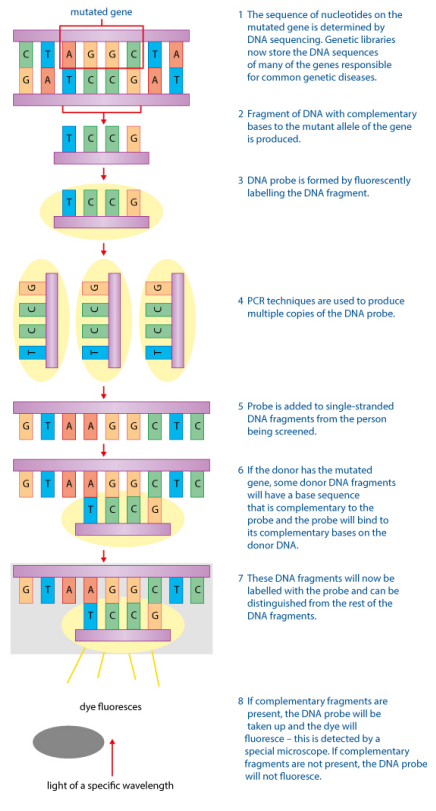
What is genetic fingerprinting?
Genetic fingerprinting is a technique that can detect differences in people DNA using variable number tandem repeats.
What are variable number tandem repeats (VNTRs)?
Short repeating sequences or bases.
Why can VNTR analysis be used in genetic fingerprinting?
The probability of two individuals having identical VNTRs is extremely low therefore VNTR analysis can be used in genetic fingerprinting.
What is gel electrophoresis?
A process used to separate the DNA fragments and proteins according to their size using an electric current.
What are the 4 stages to gel electrophoresis?
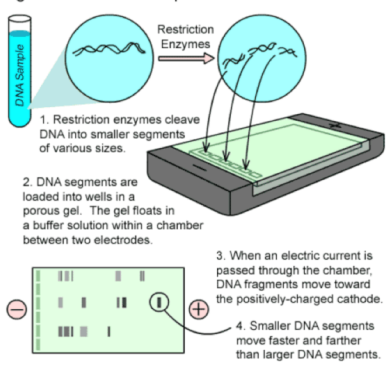
What is genetic fingerprinting?
The analysis of DNA from samples of body tissues or fluids, especially when conducted in order to identify individuals.
How can genetic fingerprinting be used?
In the fields of forensic science, medical diagnosis as well as animal and plant breeding.
How does genetic fingerprinting work?
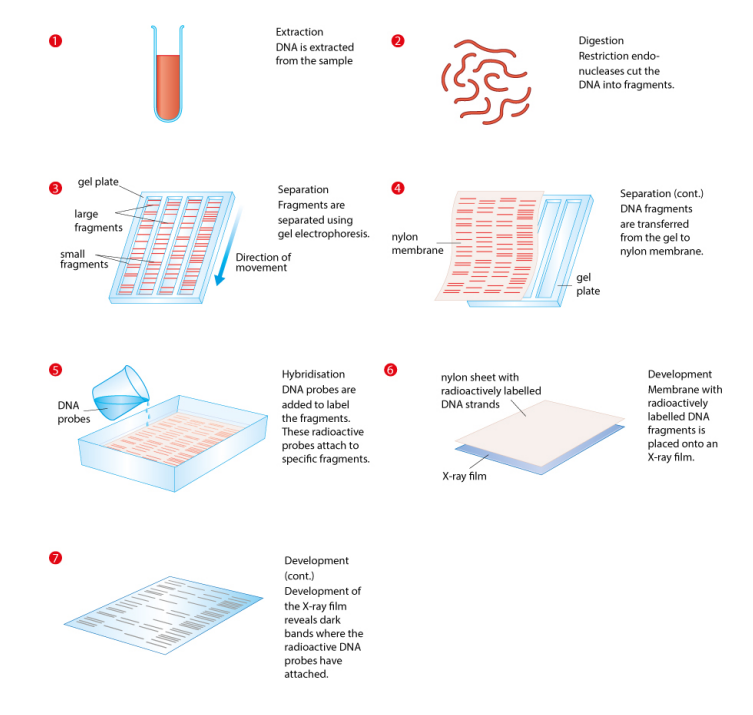
Substitution mutation
Replacement of a base by a different base in DNA;
Non-coding base sequence
Intron that does not code for amino acid / functional RNA.
Deletion mutation
Process by which a base sequence is lost from DNA;
Insertion – one or more nucleotide added in a DNA sequence causing a frameshift;
Inversion – a sequence of nucleotides reversing their order;
How a mutation changes a polypeptide
Addition / deletion / substitution;
Change in base sequence of DNA;
Change in sequence of amino acids;
Change in hydrogen / ionic / disulfide bonds;
Alters tertiary structure;
Non-functional enzyme;
No enzyme-substrate complexes form;
Effects of mutations in non-coding regions
Less / more transcription of genes for […];
Less / more translation of mRNA into […] protein;
When are mutations most likely to occur?
Mutations most likely to occur during synthesis of interphase as DNA replication occurs.
What questions would you ask yourself when evaluating cancer/ stem cell treatments?
What type of cancer / disease was treated?
What effect does the treatment have?
Was there a suitable control?
How large is the sample size?
Is the test in vivo or in vitro?
Is the test done on humans?
How long was the test for?
Was there a statistical test done?
Was there a significant difference?
Is there a correlation between factors?
Could there be other factors affecting this?
Were there any side effects / rejection?
Factors to control in cancer treatment tests
Age / body mass;
Ethnicity / genetic factors;
Health / lifestyle / sex;
Factors that increase reliability of cancer treatment tests
Large sample;
Long time period;
Different countries;
Epigenetics
Heritable changes in gene function without changes to the base sequence of DNA.
What do tumour suppressor genes do?
Tumour suppressor genes prevent uncontrolled cell division by producing proteins that inhibit cell division.
What do oncogenes do?
Oncogenes lead to uncontrolled cell division by producing proteins that stimulate cell division.
Effect of acetylation
Addition of acetyl groups to histones;
Decreased acetylation of histones;
Inhibits transcription of gene;
Increased acetylation of histones;
Stimulates transcription of gene;
Effect of methylation
Inhibits transcription of genes
Prevents binding of transcriptional factors to DNA
Attracts proteins that condense the DNA-histone complex
making DNA inaccessible to transcription factors
Oestrogen control of gene expression
Oestrogen binds to a transcription factor.
That binds to promotor region on DNA;
Stimulates RNA polymerase;
Increases transcription;
Benign tumour
Does not cause cancer or invade other tissues causing damage.
Tumour
Mass of undifferentiated cells showing uncontrolled cell division.
Malignant
Has cells that break off to spread & form new tumours in other parts of body.
Explain importance of identifying cancer early
Fewer cancerous cells / smaller tumours;
Less cell damage / fewer locations to treat;
Explain why age of disease symptoms vary
Epigenetics / stress / diet / exercise / smoking;
Methylation of genes / acetylation of histones;
Explain importance of killing all cancer cells
Cells can spread to other parts of the body;
Remaining cells continue to divide forming new tumours;